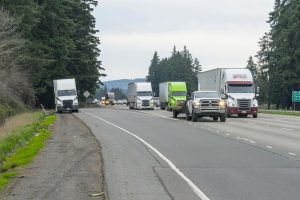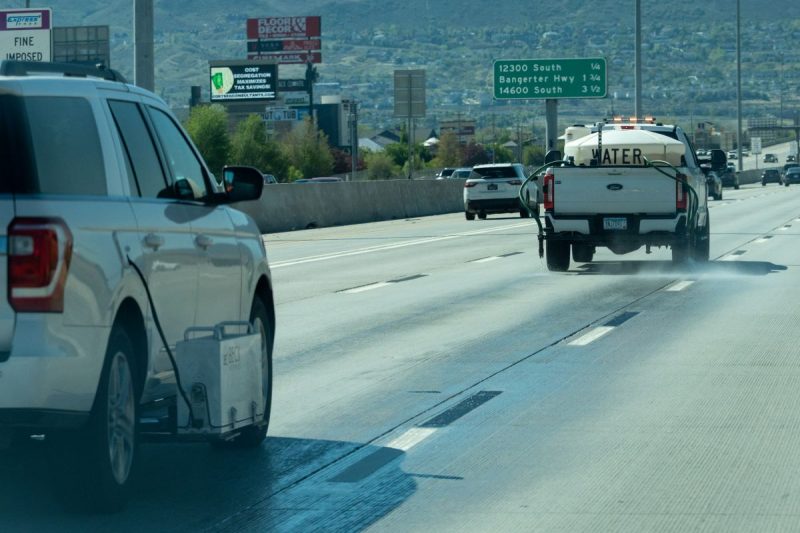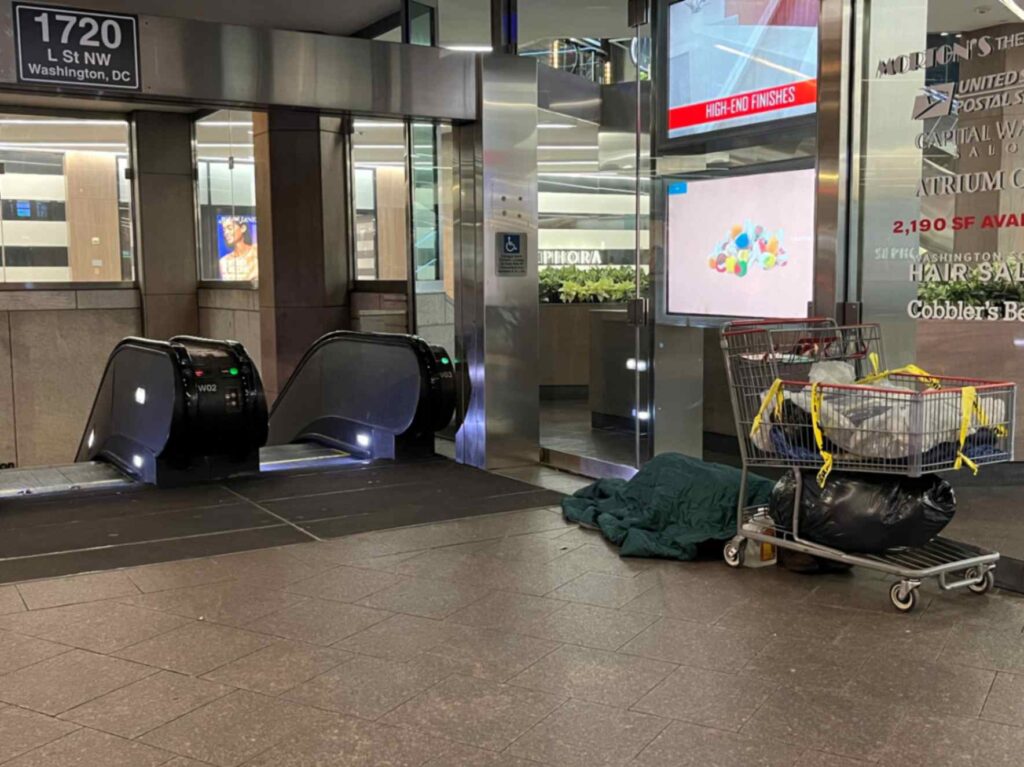 Mary Lord, TRB
Mary Lord, TRBThis article is partially derived and excerpted from TCRP Research Report 242: Homelessness—A Guide for Public Transportation.
In recent years, many public transportation agencies throughout the United States have been challenged by the effects of increased homelessness. Connecting unhoused people to services—let alone housing them—is beyond the core mission of transit agencies. Yet, because of a lack of available shelter and the challenges in many other public-policy realms, unhoused people take shelter on transit, in stations, and at bus stops.
Transit agencies cannot address the underlying causes of homelessness, but there are opportunities to work with local partners and be a part of helping individuals in need while providing a safe, reliable, and customer-friendly experience for all riders. Some transit agencies in cities such as Atlanta, Georgia; Austin, Texas; Denver, Colorado; Philadelphia, Pennsylvania; and San Francisco, California, have developed programs and initiatives to address the effects of homelessness on public transportation services and facilities and support people experiencing homelessness. In 2024, Transit Cooperative Research Program (TCRP) Research Report 242: Homelessness—A Guide for Public Transportation was released to provide a resource to public transportation agencies (1).
Overview of the Problem
From the lowest levels in 2017, the number of people experiencing homelessness has significantly grown—with the greatest jump in 2019. On a single night in the United States during 2023, an estimated 650,000 people were unhoused, of whom roughly 40 percent were unsheltered (2).
Living Unsheltered
People who are unsheltered or chronically unsheltered live on the street or within the transit system. Their circumstances are causing the greatest issues for transit agencies, and the people themselves are the most in need of help to acquire stable homes.
Cities across the United States have struggled with the effects of homelessness on their communities and the solutions to solve the needs of hundreds of thousands of people who require permanent shelter. The challenges associated with homelessness are pervasive and complex. The causes are systemic and not easily addressed by any single organization, agency, or level of government. The increase in homelessness is driven by a lack of affordable housing in the United States. There is growing evidence that housing market conditions—such as the availability and cost of rental housing—have much more influence on the prevalence of homelessness than conventional factors of poverty, drug use, mental illness, weather, and the amount of public assistance (3). According to the most recent annual survey by the U.S. Conference of Mayors, major cities across the country reported that the top causes of homelessness among families were the following:
- Lack of affordable housing,
- Unemployment,
- Poverty, and
- Low wages (4).
In addition, the compounding effect of substance-use disorders, mental illness, unstable housing, unemployment, and poverty worsen chronic and episodic diseases, making the management of homelessness more difficult (5).
Transit Riders Experiencing Homelessness
Transit agencies have been struggling in recent years with a decrease in ridership, safety concerns of riders, and increases in the number of houseless individuals on their systems. Such agencies often experience the effects of homelessness but are limited in their abilities to address the underlying causes or are unable to provide specific support to individuals in need. For many transit agencies, providing direct support to people experiencing homelessness is not core to their mission and operations but, rather, is in the purview of other city or local agencies. Transit agencies are trying to balance the need to mitigate the negative effects—such as general safety concerns, trash, human waste, unsightly conditions, destruction of property, and encampments—and to provide clean, safe transit service to all passengers.
 Courtesy of SEPTA
Courtesy of SEPTAPeople experiencing homelessness utilize transit daily to access services, jobs, education, and recreation, but they also ride buses or sleep in train cars for shelter (6). They may set up tents at transit stops, park recreational vehicles adjacent to or on transit property, or live in encampments. Studies have highlighted that homelessness negatively affects transit systems. Those effects include increased operational and maintenance costs brought on by sanitation issues, property destruction, and safety concerns from employees and riders on the system (7). The findings also show that transit agencies continue to innovate to find more effective ways to respond to homelessness and to provide connections to supportive services.
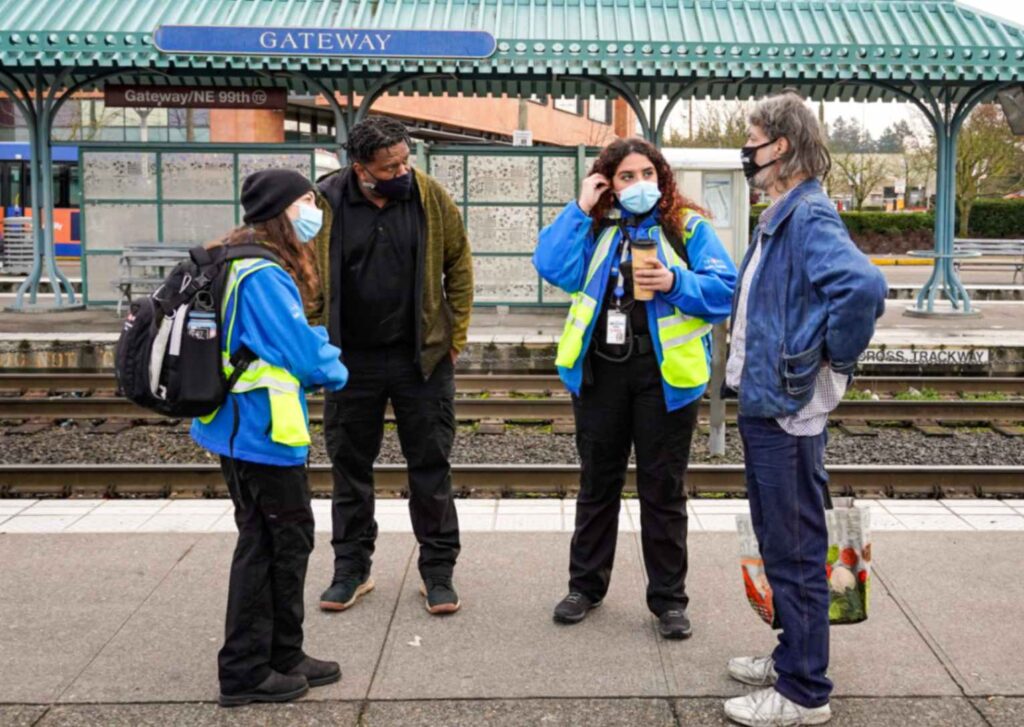 Courtesy of TriMet
Courtesy of TriMetOver the past several years, transit agencies have developed responses to people experiencing homelessness—with particular attention to people living unsheltered. These transit agencies, located around the country and in various-sized cities—such as Atlanta, Denver, Philadelphia, and San Francisco—created programs that support or provide some aid to people experiencing homelessness, while also addressing concerns from their transit agency staff members and housed riders. Other transit agencies are preparing or want to build responses to homelessness and partner with stakeholders to jointly pursue multifaceted community goals that pertain to homelessness.
Top 10 U.S. Cities with Continuum of Care for People Experiencing Homelessness (2023)
Transit agencies in cities throughout the United States are challenged with providing services to people experiencing homelessness. The following cities are among those that coordinated services and housing funding—that is, provided a continuum of care—for the largest number of people experiencing overall homelessness in 2023:
| Cities by Rank | Number of People Receiving Continuum of Care |
|---|---|
| 1. New York City, New York | 88,025 |
| 2. Los Angeles, California | 71,320 |
| 3. Seattle, Washington | 14,149 |
| 4. San Diego, California | 10,264 |
| 5. Denver, Colorado | 10,054 |
| 6. San Jose, California | 9,903 |
| 7. Oakland, California | 9,759 |
| 8. Phoenix, Arizona | 9,642 |
| 9. Sacramento, California | 9,281 |
| 10. San Francisco, California | 7,582 |
Source: 2007–2023 Point-in-Time Counts by Continuum of Care Regions.
Unsheltered homelessness affects the day-to-day activities of transit agencies in a manner that is visible to transit agency staff and riders but can also cost the transit agencies significant amounts of money to maintain the system. For example, SEPTA budgeted more than $14 million for maintenance custodians in FY2023, tripling the budget from the year before (8). In seeking to respond to homelessness, transit agencies have looked to enforce rules that people experiencing homelessness might be violating and work with local government and social service agencies to provide services or connect people experiencing homelessness to resources. Critical issues presented as challenges for transit agencies include a lack of funding and resources to address homelessness issues in transit facilities and a lack of coordination on the part of the city, county, or state governments.
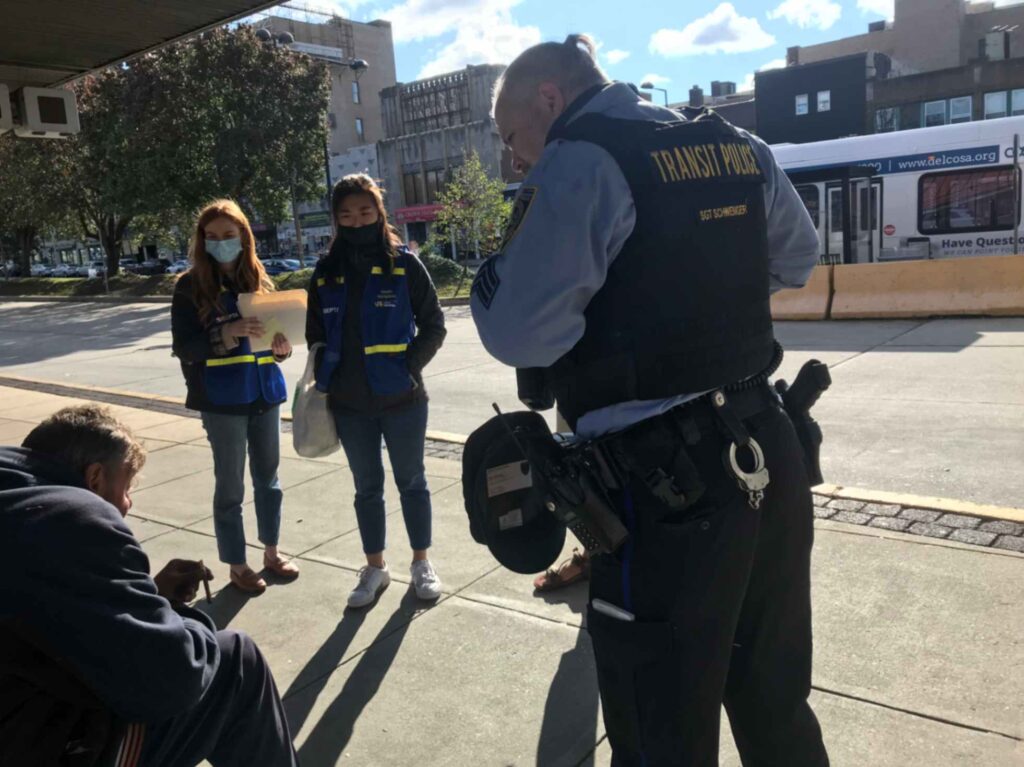 Courtesy of SEPTA
Courtesy of SEPTATCRP Research Report 242
To better understand what transit agencies are doing to respond to homelessness, TCRP oversaw a project to develop a guide for public transportation agencies and concerned stakeholders on approaches and practices that are responsive to those who are experiencing homelessness. By implementing a range of approaches, public transportation agencies can work to preserve the quality of their services and facilities for all riders, while respecting the rights and mobility needs of people experiencing homelessness, including their need for safe places to rest.
The guide focuses on supportive programs that aim to help people experiencing homelessness, while mitigating the negative impacts on the transit system, transit agency staff, and other transit system users and riders.
Supportive Activities
The following transit agency activities are supportive to people experiencing homelessness:
- Outreach services,
- Alternative emergency response and crisis intervention,
- Fare reduction or free-fare programs,
- Property site selection and low- to no-cost leasing for alternative shelter provision,
- Hygiene access, and
- Transit-oriented development with affordable housing.
However, traditional operational and enforcement-based approaches may still be part of a transit agency’s policies and practices for unhoused and housed riders. A transit agency may take a comprehensive approach to address the issues of homelessness within their system, which could include a broad array of policies and programs that meet the needs of people experiencing homelessness, as well as all other transit riders and transit employees. Initiatives to provide clean and safe places for all riders, for instance, might include activities such as enhanced cleaning programs or programs to discourage certain activities in specific areas, such as long-term sleeping in vehicles and facilities.
The guide is segmented into the following four sections:
- Providing Access and Mobility;
- Serving People Experiencing Homelessness;
- Land, Facilities, and Public Spaces; and
- Implementing an Effective Program.
Providing Access and Mobility
Transit agencies are crucial in providing access to essential services (e.g., supportive housing, social services, and employment opportunities) and mobility for patrons, including people experiencing homelessness. Transit agencies have initiated programs that benefit low-income riders—such as discounted and free fares—that especially benefit the unhoused population. For example, in 2023, CapMetro in Austin, Texas, created a program to provide eligible unhoused or housing-insecure customers a free, two-year smart transit pass. In addition, some transit agencies have started to rethink fare evasion penalties. The King County Metro transit agency in Seattle, Washington, and TriMet in Portland, Oregon, are among the agencies with programs to decriminalize fare evasion and adjudicate it through an administrative process rather than the court system. The programs also provide options to enroll in low-income fare programs instead of paying fines.
Serving People Experiencing Homelessness
For transit agencies creating supportive responses to homelessness (particularly for people living in or frequently visiting transit properties), a common strategy is to identify ways to support the people experiencing homelessness. Conducting outreach activities, connecting people to social services and housing, and building partnerships with external providers and agencies go hand in hand with the role of transit employees and safety and security personnel when responding to people experiencing homelessness and other crises. Some of the most common approaches are establishing ambassador and homeless outreach programs designed to engage and provide support to individuals on the transit system. These staff are trained in crisis intervention or partnered with crisis management staff. Though many transit agencies are working with local partners to connect people to supportive services, the SEPTA SCOPE [Safety, Cleaning, Ownership, Partnership, and Engagement] Initiative is one of the most comprehensive programs. It employs close to 50 social workers and outreach specialists to provide services across the system (9). The SEPTA outreach teams focus on connecting individuals with shelter, service providers, or other local agencies. Other SEPTA teams respond to people in crisis. In 2023, SEPTA teams engaged with more than 84,000 individuals on their system, which resulted in 7,154 referrals to social service providers and the distribution of almost 7,000 vital resources (e.g., food, clothing, wound care, and transportation) to individuals in need (10).
Land, Facilities, and Public Spaces
The management of transit agencies’ assets is extremely important in providing a safe, clean environment for all riders and employees. Transit agencies may use or offer their land, vehicles, and other property as a response to homelessness and to manage issues related to encampments. Some transit agencies are providing access to restrooms or hygiene facilities for washing, providing land or other resources to create emergency alternative shelters, and partnering to create transit-oriented development with affordable housing. Cities such as Austin, Texas; Eugene, Oregon; and Portland, Oregon, have partnered with local transit agencies to provide locations for camping or temporary living—sometimes referred to as safe sleep sites or pod villages. These locations are often managed by local social service organizations that work with individuals to find permanent housing and employment. Transit agencies provide land or ensure transit services to these locations.
Implementing an Effective Program
Program design, internal leadership, external partnerships, funding, and data collection are critical for building effective programs. Transit agency leadership plays a crucial role in responding to homelessness by setting agency direction, providing the financial and resource support needed, fostering collaborative partnerships, improving system accessibility, and engaging in outreach efforts. By working closely with local governments, social service organizations, and homeless service providers, transit agencies can develop comprehensive strategies that address the complex needs of people experiencing homelessness. Transit agencies such as San Francisco’s Bay Area Rapid Transit (BART), Los Angeles Metro, and SEPTA meet regularly with regional organizations and agencies to share information and coordinate activities. By leveraging their resources, expertise, and influence, transit agencies can contribute to comprehensive and coordinated approaches that address homelessness in their communities.
Building Partnerships Since the solutions to homelessness are beyond a transit agency’s scope and control, transit agencies need assistance from government partners, other agencies, and local organizations. Transit agencies should understand their role in managing solutions regarding homelessness and build appropriate partnerships with organizations to assist with matters outside their expertise and abilities. Understanding its limited resources and expertise, the Metropolitan Atlanta Rapid Transit Authority partnered with Hope Atlanta—a service provider for people experiencing homelessness—to improve unsheltered individuals’ access to resources and services. Working together, they focus on direct, individual outreach to people experiencing homelessness.
Defining Success What success or working effectively looks like varies, depending on the location’s circumstances, goals, and organizational culture. Many transit agencies reviewed for TCRP Project J-11/Task 40—from which TCRP Research Report 242 was produced—were collecting some type of data and tracking metrics. For instance, metrics may include the number of people contacted for outreach services or the number of people sent to mental health care instead of being arrested. The University of California, Los Angeles (UCLA) team asked the transit agencies they surveyed about their definitions of success (6). However, as the UCLA study cautions, homelessness response activities “may be evaluated along many potentially contradictory axes (from removing or reducing the numbers of unhoused riders from transit systems to providing them with free fares, offering outreach services, or connecting them to health or housing services)” (11). Analyzing only one outcome measure—such as “fewer people experiencing homelessness riding transit vehicles for non-destination travel and living on transit facilities”—does not explain what aspects of a program are successful. It is important to track a comprehensive set of measures—including performance, process, and outcomes—to truly understand the effectiveness of programs.
APTA’s National Workgroup
Though the guide provides an overview of programs, initiatives, and activities currently being used by public transportation agencies, this is an evolving field of knowledge and experience. Transit agencies rely on other agencies to build peer networks for sharing lessons learned. In 2021, a group of transit agencies struggling with the growing challenges of people experiencing homelessness and other issues related to mental health and substance abuse on their systems formed a workgroup. This informal group of transit agency staff meets monthly to share information about agency practices to address public safety concerns. While their focus is broader than strictly addressing issues related to homelessness, there is overlap with how these transit agencies are rethinking their approaches to crisis management, community engagement, employee training, and public safety and security. The workgroup was started by representatives from BART, CapMetro, Dallas [Texas] Area Rapid Transit, Denver Regional Transportation District, and TriMet but has expanded to include more than 10 additional transit agencies. Recently, the workgroup became an ad-hoc subcommittee of APTA, with the mission to support the development, implementation, and operation of transit programs that assist vulnerable populations such as people experiencing homelessness, mental health challenges, or issues with substance abuse (12). Activities of the subcommittee, known as the National Transit and Vulnerable Populations Workgroup, as well as key educational resources and best practices for transit agencies interested in research, strategies, and programs, will be shared on an APTA webpage.
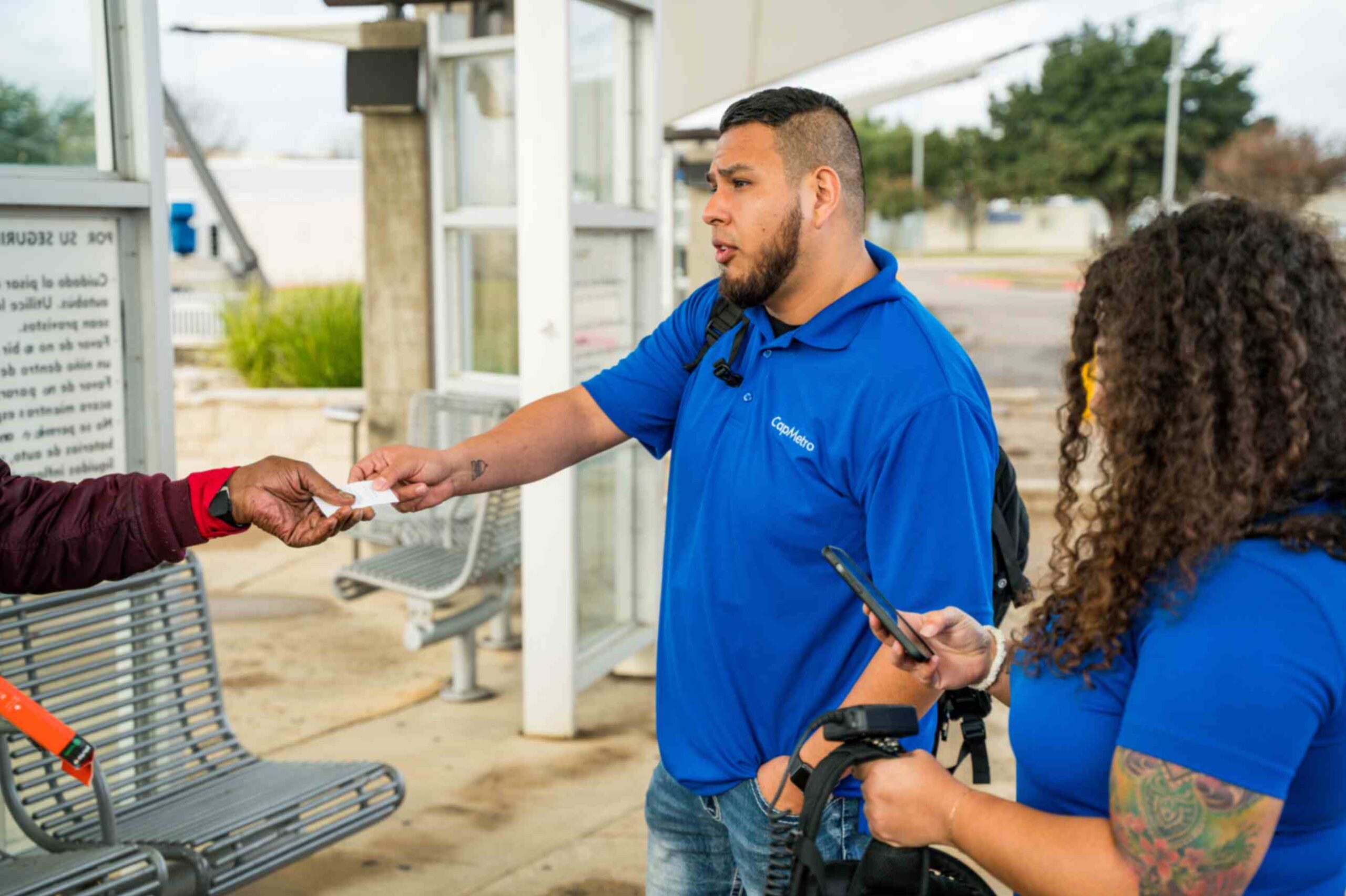 Courtesy of CapMetro
Courtesy of CapMetroConclusion
Transit agencies have been at the forefront of engaging people experiencing homelessness while trying to maintain a safe, reliable, and customer-friendly experience for all riders. TCRP Research Report 242 provides an overview of programs and initiatives that transit agencies are using to address issues on their systems, while also taking part in community solutions for ending homelessness. There is still a need to build a knowledge base of these activities, such as developing program evaluations that include cost analyses and effectiveness, as well as data, metrics, and performance measures.

